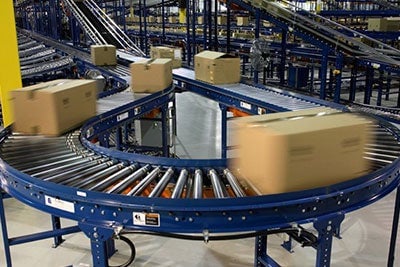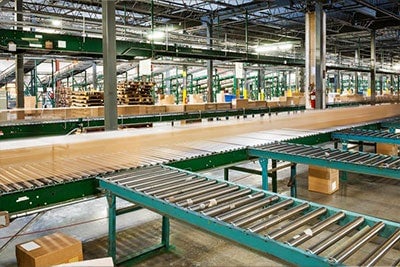What is a Warehouse Management System (WMS)?
- 10 March 2023
- By Manhattan Staff

Have you ever wondered at a high level, what a warehouse management system (sometimes referred to as a WMS) really is? Maybe you're new to the industry or doing your first step of research for a modern WMS solution. If so, read on. We have answers!
A warehouse management system (WMS) is a supply chain software solution that oversees, streamlines and coordinates every aspect of distribution in a warehouse or distribution center. It is used by manufacturers, distributors and merchants of all sizes to drive the utmost efficient labor and fulfillment capabilities and to maximize inventory storage. In short, it optimizes warehouse inventory management software and operational capabilities.
Have a look through these highlights to learn more about WMS.
Why is a modern WMS so important?
WMS is a vital component for any national or global supply chain operation as it keeps track of every single product item that goes in and out of distribution.  A modern WMS provides full enterprise-wide visibility of inventory and complete visibility of a product’s journey from the warehouse to the store shelf (or a customer’s front door).
A modern WMS provides full enterprise-wide visibility of inventory and complete visibility of a product’s journey from the warehouse to the store shelf (or a customer’s front door).
Supply chain technology and the overall supply chain ecosystem have faced numerous disruptions in recent years due to the pandemic and resulting ecommerce fulfillment boom. Customers are now demanding more out of supply chains and businesses require the best warehouse management capabilities on the market to meet those demands, especially with direct-to-consumer fulfillment methods becoming a norm.
What are the attributes of the best WMS on the market?
Despite the strains on today’s supply chain operations, most of the industry is still saddled with legacy solutions siloed from each other. These technology architectures are incapable of truly unifying supply chain and warehouse management processes. They are limited by large monolithic databases, customizations that must be duplicated over and over for every upgrade, and an untenable number of integrations.
To keep pace with this new normal, businesses need to ensure that their supply chain is running at optimal efficiency. This requires a modern WMS, such as Manhattan Active Warehouse Management, built with 100% microservices and born in the cloud. This architecture enables WMS capabilities such as slotting optimization, labor management, robots and automation, and task management to work in unison and ideally with existing solutions in a cloud-native environment where they can receive seamless upgrades, making the lives of your employees and customers that much easier.
What is meant by cloud-native?
The term “cloud” has become generalized to cover any solution being maintained outside the walls of an enterprise. Typically, terms like “runs on the cloud” or “hosted in the cloud” represent legacy architecture that has been modified to run in a remote data center.  Solutions like these do not take full (or often any) advantage of cloud architecture. They still struggle with issues like extensions, implementations, upgrades, scalability, and more.
Solutions like these do not take full (or often any) advantage of cloud architecture. They still struggle with issues like extensions, implementations, upgrades, scalability, and more.
Conversely, “cloud-native” applications are born in the cloud, capitalize virtualization and containerization, use APIs extensively and leverage the scalability of the internet to autonomously harness vast amounts of computing power. These differences make them significantly more scalable, dependable and affordable. They also are the only solutions that can meet the needs of modern supply chain and warehouse management systems.
100% microservices
The right supply chain solutions are built entirely with microservices or discrete functional components that eliminate the need to duplicate capabilities and data. Technology, such as Manhattan Active Warehouse Management, shares the same composable, microservices components. That means they never need upgrading and they are fully extensible, which allows companies to plug in their own innovation, without impacting future updates.
They are scalable, automatically adding capacity to meet spikes in demand and then reducing it when the needs lessen. Microservices architecture also seamlessly and continuously adds new innovations and capabilities over time. It is designed specifically and uniquely for the modern supply chain world.
Slotting optimization utilizing applied intelligence
Slotting optimization places each item of inventory in the ideal location of the warehouse or distribution center based on calculations relating to the characteristics of the item and storage location layout. It utilizes applied intelligence and data to calculate factors such as product seasonality, sales trends, product variations, item size and which items are fast-moving, to determine the best location to be picked and disbursed. Learn more about slotting optimization from this Manhattan Active Slotting page.
Enhanced planning with a Labor management system
A labor management system optimizes workforce management capabilities through enhanced planning and employee performance calculations. It analyzes every aspect of labor productivity to get the most out of warehouse employees and operations.
The best and most modern versions of WMS access real-time workforce performance data to provide a new approach to employee engagement.  This includes digital mapping of facilities and workforce tasking, real-time employee and AI performance data, two-way communication between supervisor and tasking employee, and advanced gamification that provides worker incentives based on calculated data by department and job function.
This includes digital mapping of facilities and workforce tasking, real-time employee and AI performance data, two-way communication between supervisor and tasking employee, and advanced gamification that provides worker incentives based on calculated data by department and job function.
Robotics and automation - more important than ever
With the current supply chain volatility and accompanying labor shortage issues, automation has become more important now than ever before. Modern robotic capabilities are playing a large role in warehouse management automation, with unprecedented intelligence and optimization leading the technology to become increasingly more efficient, sophisticated and faster.
The key to advanced automation success in a warehouse is allowing automation, robotics and people to work together. Historically, WES (Warehouse Execution Systems) were developed to manage work tasking and optimization of mechanized automation. The problem is WES and WMS capabilities initially worked separately from each other, and legacy WMS was not capable of handling the capacity and complexity of advanced automation and robotics. The best WMS has integrated with WES and infused its capabilities together, getting the most out of both humans and machines.
Task management technology
Task management technology continuously plans, learns, and re-plans every task and resource simultaneously across retail, wholesale, and direct fulfillment workflows. Once an order arrives, it is streamed individually or sorted into wave-like collections depending on the urgency, type of fulfillment and customer need. Watch this great video on order streaming explained to learn more.
The benefits of a unified supply chain
Modern warehouse management solutions are built on a single platform, which opens the door to unification and flawless modern experiences.
A unified supply chain, with WMS, labor management, slotting optimization, and transportation management software (link to TMS) all working together in a symbiotic cloud environment can unlock unprecedented supply chain agility, visibility and execution — all on a single device.
Manhattan Active® Supply Chain brings our WMS and TMS capabilities together to form end-to-end supply chain optimization, visibility and a level of execution never before seen. In a post-pandemic world, these are the survival traits brands need. And they are only possible with a unified supply chain solution platform. Find out more from this Manhattan article about future store trends.
How to choose the best warehouse management system
In today’s omnichannel, post-pandemic world, having the right WMS that optimizes all demand, supply, labor, slotting and automation across every facility in the network enables more efficient workers and results in more satisfied customers.  It earns the customer’s trust that they will receive each purchased item, in a timely fashion, how, when or wherever they wish to receive it, which is vital in a now uber-convenient market. The best way to achieve this is through a cloud-native WMS and unified supply chain solutions.
It earns the customer’s trust that they will receive each purchased item, in a timely fashion, how, when or wherever they wish to receive it, which is vital in a now uber-convenient market. The best way to achieve this is through a cloud-native WMS and unified supply chain solutions.
Why Manhattan Active Warehouse Management?
Manhattan Active Warehouse Management is the world’s best enterprise-class warehouse management system (WMS) that unifies every aspect of distribution and never needs upgrading, and is a 14-time leader in Gartner® Magic Quadrant™ for Warehouse Management Systems. See these real-life case studies for how other organizations have implemented Manhattan solutions with great results:
- Crocs and Manhattan find the perfect fit with Manhattan Active Warehouse Management – read the case study.
- Raia Dorgasil Optimizes Warehouse Management with a Manhattan Prescription - read the case study.
- Pet Supplies Plus finds a new best friend with Manhattan Active Warehouse Management – read the case study.
What does your warehouse management supply chain solution look like? Request a demo or contact us to unlock the optimal warehouse management software.




